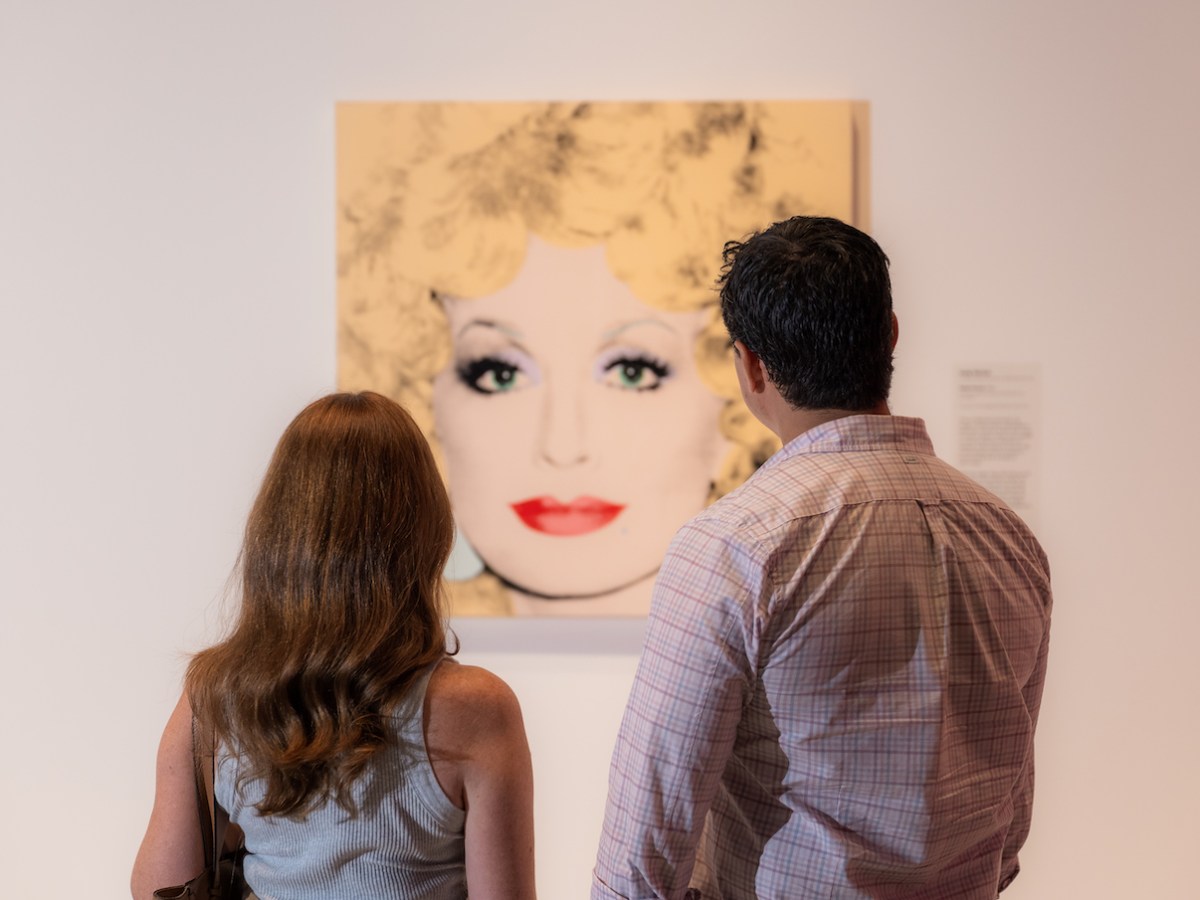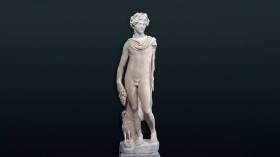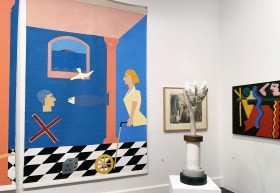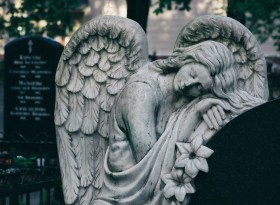Estimated at $1.115 billion (US$770 million), the New York-based Mugrabi Collection holds over 800 Andy Warhols – the largest holding of any art collection in the world. It also holds a decent wad of artworks by Renoir, Picasso, Rodin, Damien Hirst, Jeff Koons, Keith Haring and Jean-Michel Basquiat, among others. So how have a selection of the works ended up on the Gold Coast, in an Australian first?
Tracy Cooper-Lavery, Director of HOTA, Home of the Arts and co-curator of the exhibition Pop Masters: Art from the Mugrabi Collection, New York with HOTA Curator, Bradley Vincent, tells ArtsHub that it was the luck of a cold contact.
Through her connections, she managed to get a direct email of the lawyers that represent the Collection. ‘I basically, out of the blue, said, “Look, you don’t know me yet, but this is what we’re doing. This is what the Gold Coast is, this is what our ambitions are, so what do you think?” As ridiculous as it sounds, that’s how it happened.’
Cooper-Lavery was hired into the role on her success at Bendigo Art Gallery, driving audiences through international programming. ‘When I took the job here, the ambition that the city had was to build on “the Bendigo effect” [art-driven tourism] and really explore international programming for the gallery.
‘The Mugrabi Collection is a perfect fit for the Gold Coast – for this institution – and it also demonstrates why this building was built. I mean, this is what we were made for,’ adds Cooper-Lavery.
That, however, comes at a cost. In an interview with Haaretz, American-Israeli textiles mogul, Jose Mugrabi, claimed: ‘I get something like [US] $2 million for every exhibition I lend collections to… It’s a commercial thing.’
Without disclosing their deal, Cooper-Lavery confirms, ‘We certainly negotiated a fee, and it is a higher fee than you would normally pay for, say, an institution-led exhibition. I’m not disputing that it is quite a considerable fee. However, the flip side of that is that they manage the insurance – that’s the trade-off.’
Six years in the planning, and at one point mooted to be the gallery’s inaugural show, the ticketed exhibition will be the first international exhibition presented by HOTA, since it opened two years ago. Cooper-Lavery acknowledges that a global pandemic and escalated freight costs played a role in its timeline.
‘We’re starting to roll into our second year of operations, and we haven’t been able to get a baseline for visitation. Other galleries have that data from pre-COVID … I feel like it’s the first time that we’ve really got a good window to get people here for a major exhibition and get a sense of what we can achieve,’ Cooper-Lavery tells ArtsHub.
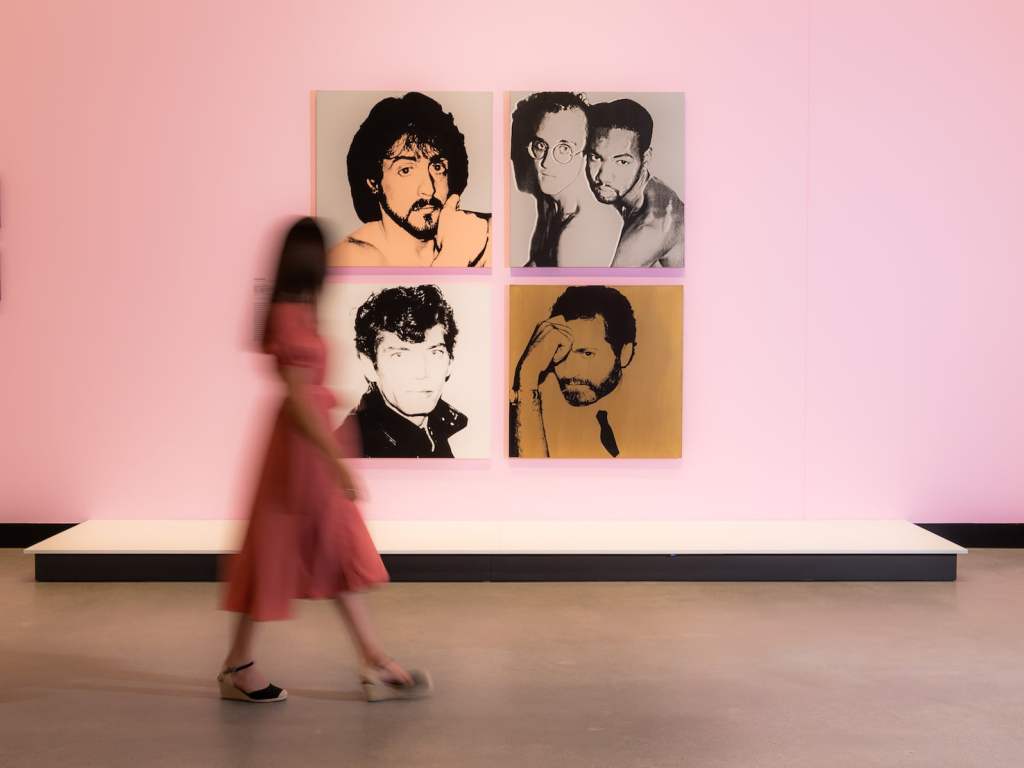
What does a Gold Coast coup look like?
Cooper-Lavery describes the exhibition as ‘a kind of crash course in American culture’. She continues, ‘We’ve been working with these lists of potential inclusions for years, but seeing these artworks on the walls, the other day Bradley said to me, “it’s all killers, it’s no fillers”. And that’s how it feels; all of these works are really significant and really important.’
It’s a view echoed by the team of Mugrabi installers, who travelled with the artworks from New York. Cooper-Lavery says, ‘The really exciting thing for me is that, they’ve come from the other side of the world, and they’ve gone, “Wow, these guys actually know what they’re doing”.’
The exhibition comprises 54 artworks, with around half being pieces by Warhol. Also included are works by Jean-Michel Basquiat and Keith Haring in conversation with artists Katherine Bernhardt, Kwesi Botchway, George Condo, Damien Hirst, KAWS, Jeff Koons, Joel Mesler, Richard Prince, Tom Sachs, Julian Schnabel, Mickalene Thomas and Tom Wesselmann.
‘We wanted to ensure Warhol was well represented and showing that connection of where he fits in this kind of overarching Pop universe,’ says Cooper-Lavery.
Now in his 80s, Mugrabi started collecting with his wife Marie in 1982, and today his two sons are very involved in the Collection’s management. ‘Until I was 40, I’d never seen art or knew what it was,’ Mugrabi told Haaretz.
The exhibition is loosely sectioned into zones that celebrate Warhol, then Haring and lastly Basquiat, with each zone peppered by other artists both from that period and later influenced by it. Among the line-up of works is Keith Haring’s epic Untitled (Dancing Dogs) (1981) – which Cooper-Lavery says was loaned to HOTA in preference to a request from The Broad Museum in Los Angeles for its upcoming Haring survey. ‘It feels like we’ve pulled a piece of New York street art straight off a wall and into the gallery,’ she says of this iconic painting.
It sits within view of George Condo’s Untitled (Choo Choo) 2009, Haring’s stylised dogs bouncing off the Top Cat character. Condo was a studio assistant for Warhol in the Factory on his superheroes series.
Another star piece is Jean-Michel Basquiat’s New York, New York (1981) – said to be one of the first he exhibited in a commercial gallery blurring that crossover of street art and ‘high art’ – sitting within view of a new Collection commission by KAWS (and never exhibited before), the 2.8-metre tall bronze sculpture, What Party (2018). Cooper-Lavery says it extends the Pop vernacular to a next generation, and allows those narratives and influences to weave across time.
This sits alongside Damien Hirst’s When They Were Down They Were Down (2007), a steel and glass shelved installation displaying 4500 pills. ‘Every single pill has a position, has a physical direction in the way it’s got to sit, with instructions how it should be placed. So [it’s] carrying forward from Warhol’s Factory to these artists, who have their own kind of factory to produce these extraordinary things, like Jeff Koons or Damien Hirst. There’s a chance their hand hasn’t even been in these works,’ explains Cooper-Lavery.
Overall, the scale and quality of the works on display is exciting, and offers a viewing experience commensurate with any world-class museum.
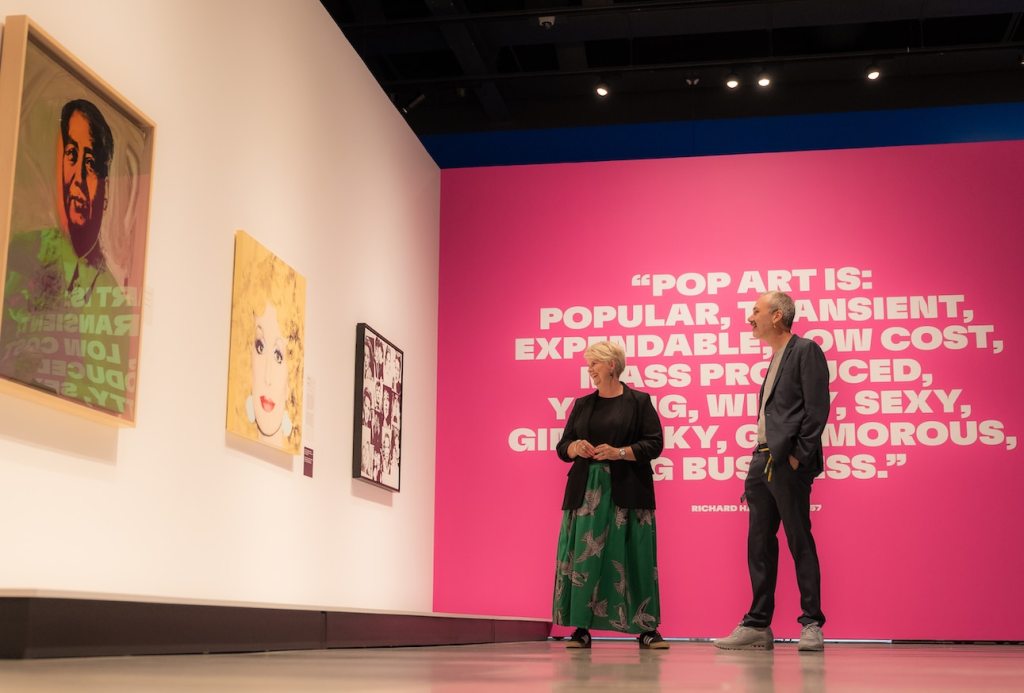
Security and social topics
In November last year, Australia became victim to a new kind of activism, with news of a climate protestor gluing themselves to a Warhol artwork at the National Gallery of Australia. It followed an earlier incident at NGV International during its Picasso blockbuster.
It is a concern for any gallery director today presenting a high-profile exhibition. Cooper-Lavery says, ‘We have done what we can to ensure that this exhibition is safe,’ adding, ‘I’m sure it’s part of everybody’s management plan now.’
With Mugrabi’s Syrian Israeli background, a further platform for fundamental commentary is embedded in the Collection. ‘Certainly, we’re aware of all of those things. And we’ve put in place the measures that we can to ensure we’re doing everything to keep these works and the audience safe.’
Therein lies an interesting twist. Several of the artworks in this exhibition draw attention to social issues of their time. In particular Warhol’s Sixteen Jackies (1964) and Kwesi Botchway’s blacklivesmatter (Divine Protesting), 2020, which sits adjacent to Jean-Michel Basquiat, Procession, 1986. These works demonstrate the power of art to have a voice on important issues.
Cooper-Lavery says that, while Botchway’s piece is ‘probably the longest bow in terms of Pop’, she adds, ‘If we’re talking more broadly about social history and challenging conversations of the time, it’s obviously a very current work that is going to have currency for years to come.’
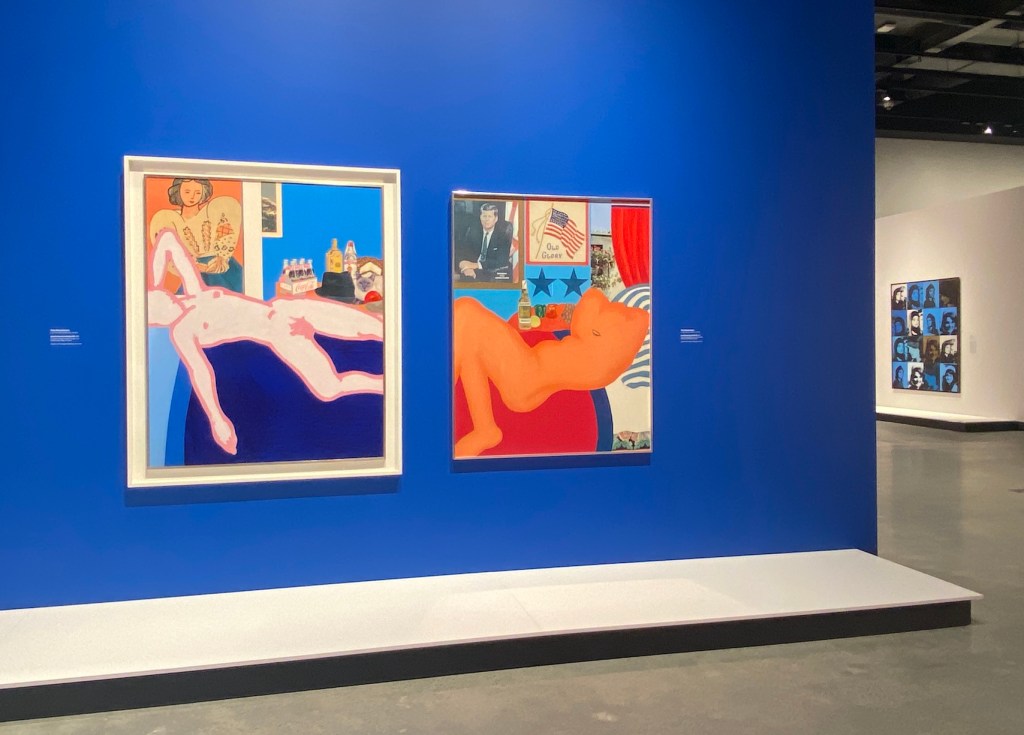
‘To a degree, it speaks to a pairing earlier in the exhibition of Tom Wesselman’s image with JFK (John F Kennedy) as the kind of shining new hope and Warhol’s Sixteen Jackies, of frozen moments post his assassination, and that idea of how the media actually plays into the narratives of the day. That is what I find really interesting with this exhibition,’ says Cooper-Lavery.
It is rather fitting then that the exhibition concludes with an NFT (non-fungible token). In 1985, Commodore International gifted Warhol an Amiga 1000 computer loaded up with ProPaint software. While the software didn’t survive, what Warhol made has… well, just. The outdated floppy discs were discovered when artist Cory Arcangel teamed up with Carnegie Mellon University, the Carnegie Museum of Art and the Andy Warhol Museum to recover them in a three-year long restoration project, initiated in 2011.
Christie’s auction house teamed up with The Andy Warhol Foundation to mint five NFTs from the digital files to raise money for the Foundation. A banana was purchased at auction by the Mugrabi Collection in 2021, and is today making its way to HOTA. For many Australian audiences it will be the first NFT they have seen exhibited. It offers a canny point of departure, with another discrete work and the earliest in the exhibition, Warhol’s 15 Dollar Bills (1962), which was drawn entirely by hand, and made before he moved into his photographic screenprints.
Read: NFT rights for artists and buyers
The enduring cult of Pop in Australia
Australians clearly love a Pop exhibition. Pop Masters: Art from the Mugrabi Collection, New York opens on the Gold Coast within weeks of Andy Warhol and Photography: A Social Media opening at the Art Gallery of South Australia for the Adelaide Festival, and the NGA Touring exhibition, Lichtenstein to Warhol: The Kenneth Tyler Collection at Cairns Art Gallery.
These exhibitions join a string of ‘fan-ish blockbusters’ that stretch back two decades: Andy Warhol Portraits (MCA, 1993), The Andy Factor (ACCA, 1997), Andy Warhol (QAGOMA, 2008), Andy Warhol’s Jewish Geniuses (Jewish Museum of Australia, 2014), Pop to Popism (AGNSW, 2014), Andy Warhol and Ai WeiWei (NGV International, 2015) and Keith Haring | Jean-Michel Basquiat: Crossing Lines (NGV International, 2019).
How is this exhibition different? Cooper-Lavery says, ‘[The HOTA] show continues to add to that story. There hasn’t been a show that’s put them all together – these connections – and brings them all together visually. I think it’s something really new and fresh.’
She continues, ‘Australia doesn’t really have the opportunity to have access to a lot of these artworks and artists on this scale. We wanted to really talk about what New York was like, and how all these artists knew each other, worked together, and were influenced by each other, and to just dig a bit deeper into that.’
Pop Masters: Art from the Mugrabi Collection, New York is showing at HOTA: Home of the Arts on the Gold Coast, from 18 February – 4 June 2023. It is a ticketed exhibition. $25 entry.
The writer travelled to the Gold Coast as a guest of HOTA.

